 اليوم أحباء ليلاس الأفاضل أقدم لكم
اليوم أحباء ليلاس الأفاضل أقدم لكم
بلانغ انز السانتي جميل جدا رغم صغر حجمه
MemoryMoon v1.3 VSTi
Memorymoon is inspired by the clic synthesizers. The
sound is powerful. It has 6 voicecards with 3 oscillators,
noise oscillator, amp and 2 filters. Settings above 5V in
the mixer introduces overdrive.
Features include: 6 voice unison. Osc sync. Many envelope
curves. Graphic envelopes. Arpeggiator and trancegate. Hold
function. LFO, Voice-LFO, and Delay-time can be synced to
host clock or to tapped tempo. You can tap tempo with a
sustainpedal or with a button.
There is "voice-card drift" settings for tune, amp, filter
cutoff and pulse width. So each voice-card can sound
slightly different. It is also possible to play soundfonts
and drum-loops in wav-format. This is intended for live
performance.
تفاصيل البرنامج
FILTER
Level: This is balance control for the 2 filters. It is also on/off switches for the filters. (Set volum 0V to save CPU). It is also gain settting for the built in overdrive in filter 2.
Cutoff: Frequencies lower than this setting will pass the filter. (Lowpassfilter). Emphasis=Resonance. Gives more emphasis to the frequency set as cutoff frequency. Emphasis and KB Track is common for both filters.
KB track: Makes the highest notes brighter. It is a cutoff frequency compensation. Mode: Filter 1 can be in lowpass, bandpass, highpass or notch mode.
Filter1 cutoff is not realtime (calculated for every 4th sample), and this might cause clicks with fast envelope, and it is most noticeable in bandpass mode.
Filter2 has large amounts of built-in distortion to enchance the sound.

Contour=Envelope. Affects how the sound develop over time. Here is how to adjust an effect patch using the filter contour:
For a rising effect: Choose attack 6 volts. For a falling effect: Set attack to 0 and decay to 6 volts. Attack is the rising time, decay is the falling time. Sustain is the level after the envelope is finished and you still hold down a key. Release is the fade out time after the key is released.
Contour amount is level for the filter envelope.
You can select the filtermodel for filter 2. It is basically 15 filter models with fast (low CPU)
versions of all filter models. The default model is 4-1:5. The 4:4 filter has a smoother resonance.
This is what the developer Rick Jelliffe says about the different filter configurations:
* The configurations with an "f" are fast versions which do not model analog component variation. the components without an "f" model the .5-5% variations in values of the discrete resistors and capacitors of old real analog components and may be quite CPU intensive. The modes which do not have an "f" are designed to distort well: Users may prefer to drive over the customary levels. (In memorymoog the filter2 level).
* The configurations are typically named using two numbers divided by a ":".
The first number represents how many filter stages (called "poles" probably innaccurately) the signal goes through before it is sent to the output. The second number represents how many stages the signal goes through before it is fed back into resonance. So "4:4 pole" is nominally more like a Moog 24db/8ve filter, while "2:2 pole" is nominally more like an Oberheim 12 db/8ve filter. (To my ear, however, the "4:5" and "2:3" filters do better emulations.)
* There are a few configurations where before the ":" are two numbers separated by the minus sign "-". In these cases, the number after the "-" represents one or more small high-pass stage added, which makes the filter like a lop-sided band-pass filter. So "4-1:5f" means that the output signal is the result of four low pass stages and one high pass stage, and that the resonance is based on 5 stages.
You can make the graphic envelopes visible with this button:
And it looks like this:
The envelope section has a lot of options:
Return to zero: Retrigger envelopes each time you hit a new note.
Complete cycle: Complete attack and release stages.
Keyb. follow: Shorter sounds in the highest ranges. (Like a piano).
Release: Release stage off/on
Curve: How the signal moves from one stage to the next. Linear is standard in most digital synths, but the old analog synthesizers had very musical curves. I think inv. exp+exp curve is the original memorymoog curve.
MODULATION
LFO
Rate: Speed from 0.1 to 100 Hz.
Sync: Sync to host clock. Overrides rate knob when on.
Level is also available in control section: "Wheel LFO"
SH-waveform may be used as a random generator.
The lower row is destinations:
OSC1 FRQ: Oscillator1 pitch
SOUNDFONT: Soundfont oscillator pitch
PW1: Oscillator 1 pulse wave modulation. (Pulse length).
FILTER1: Filter 1 cutoff frequency.
Voice-LFO: Osc 3 and filter envelope used as modulation signal.
The levels of osc 3 and filter envelope is mixed and used as modulation signal.
Contoured osc amount: Filter envelope modulates the modulation signal.
Invert: The modulation signal is inverted.
The lower row is destinations:
VCF1 PAN: Pan modulation of filter 1
Osc2 ring: Modulation signal sent to osc 2 as ring modulation.
"Drift" in Osc 1 section is controlled by Voice-LFO.
CONTROL
Page 1 Edit (All controls in one view).
Page 2 Keyboard
Page 3 Soundfont/Drumloop edit.
Autotune: Affects osc2 (pitch and fine-tune) osc3 fine tune and master tune. Brings the instrument back in perfect tune.
Bend amount: Bend interval in semitones.
Wheel LFO rate: Modwheel increases LFO rate.
CPU-save: All soundcards sent to only one filter (instead of 6 filters). Only one filter and one filter envelope. If you think the keyboard respone is weird: Turn it off. If you experience too much distortion in filter 2: Turn it off. (Filter 2 has built in overdrive, and 6 voicecards into filter 2 is a bit too much. Use filter 1 instead when CPU save is on.)
Mono: Mono/Unison mode on. 6 voice poly when turned off. Next to the mono button: Select priority and the number of unison voices from 1 to 6.
Octave shift: At strong velocity the osc pitch is one octave higher.
Wheel osc2: This is a weird control intended for distortion. Osc2 is 5 semitones lower when mod wheel is at zero position (for power chords). 'When modwheel is at max osc2 pitch is normal.
Panic: Send "all notes off" midi messages to all parts of the synth.
Wheel LFO: LFO level controlled from modwheel.
Foot LFO: LFO level controlled from foot pedal.
After filter: Aftertouch increases filter cutoff frequency.
AMP velocity: Velocity controls output level and envelope speed.
FILTER velocity: Velocity controls filter cotoff frequency.
OSCILLATOR SETTINGS
On top of the synth you can select the square waveform:
(Square (PW), Noise (BPF), Bi-Pulse (PW), Morph Triangle,Saw-Square.)
The default square is "Square (PW)". All selectable waveforms do morphing from PWM modulation:
Square (PW): Pulse width
Noise (BPF): Sets the resonance of the bandpass filter
Bi-pulse (PW): Pulse width
Morph Triangle: Pulse width
Saw-Square: Set's the ratio between Sawtooth and Square wave
Low: Osc 3 in low mode. Used when osc3 is modulation signal in the Voice-LFO section. The pitch is 5 octaves lower in low mode.
Keyb. control: When on incoming midi messages will control the pitch of osc3. When off osc3 is free running. When on in low mode each voicecard will have different Voice-LFO speed.
Sync: Sync to host tempo.
Detune: Each voicecard has different pitch.
Pulse: Each voicecard has different pulse.
VCA: Each voicecard has different level.
Filter: Each voicecard has different cutoff frequency. (Does not work in "CPU-save" mode.)
OSC DETUNE: Detuning of the individual waves in each oscillator.
MIXER:
Each oscillator + the noise generator has a level knob in the mixer. Range is 0 - 10 Volt. Note that over 5 volt is overdrive, and the sound will be smoother instead of louder above 5 volts.
SYNC
This button forces the pich of oscillator 2 to follow the pitch of oscillator 1. So you set the pitch for OSC 2 in the OSC 1 section. The trick is to sweep the pitch of OSC 2 with the LFO, so that the sync gets some pitch-variations to work with.
GATE / ARP SECTION
What you see above is gate off/on switch and tempo control.
Tempo control is also sent to LFO sync, Osc3 sync and Delay sync.
Speed: How the tempo is divided for use with the gate and arp. The LFO, Osc3 and delay has its own divide controls.
Sync: Sync to host clock. Use this setting when you compose songs. Off mode is intended for live use.
The other controls is for live use:
Foot tap: Tap tempo with sustain pedal intead of the tap button.
Tap 4 times: The tap tempo button.
BPM: Actual speed display.
Tempo slider: You can use this instead of the tap button when sync is off.
Lenght: Note length. Full is 100%
Octaves: The arpeggiator will work with 1 - 4 octaves.
Hold: Use this in addition to the hold button in the control section.
First row: Step 1 - 16 off/on
Second row: Can be sent to filter cutoff or oscillator frequency. (Not to osc3).
Third row: Can be sent to filter cutoff or oscillator frequency. (Not to osc3).
PAGE
Page1: Edit page. All controls in one view.
Page2: Keyboard page.
Page3: Soundfont and monitor page.
SOUNDFONT PAGE
How to load a soundfont: Click the (load) text to the left. The soundfont is remembered with patch. Also remember to turn up volume in the mixer section.
Only one envelope is available and can be turned off/on for both the amp and filter.First row is amp. Second row is filter+hold-function.
The last row is the .wav-player. It is always in loop mode.
File-loop: Use the loop preprogrammed into the wav-file. (If there is one).
OVERDRIVE

This is distortion. When set to off, the signal is bypassed, and that will reduce CPU-load.
Before filter is overdive both before filter 1 and filter 2. Because overdrive must be calculated for 6 voices, and for 2 filters (when both filters levels is higher than 0 volt) it must be calculated for 12 voices in poly mode.So the "before filter" option is very CPU hungry.
When you increase the gain knob, the sound will become more and more like a square wave.
Overs 2x: This is 2 times oversampling.
High cut: Will remove the highest frequencies. This is like a speaker simulator. A guitar amp does not have much energy above 5 kHz. With a middle setting (5V) this knob emulates a speaker cabinet. At max setting the sound is clean and uncoloured. High cut does not work when distortion is in "before filter" mode.
DELAY
Sync=Syncronization with host clock. Set sync speed with note values.
Sync off: Set speed with SPEED knob.
Right speed 1X: Only one delay is active. This saves CPU.
Right speed 2X: This activates a second delay. A delay-signal with double speed is sent to right output, while the first delay is sent to left output. If you raise the feedback value the result will be ping-pong delay.
Feedback=Number of repetitions.
MODULATION EFFECTS
Modulation: off/on and select chorus or phaser.
Level: Dry/Vet balance. 10V is 50% chorus and 100% phaser.
Speed: Modulation speed.
Phazer resonance: The phazer has a resonance control.
REVERB
Size: The room size.
Decay: The reverb length. Similar to delay feedback.
CPU ADVICE:
There are off/on switches connected to the level knobs. Because of that you should always make sure that unused parts of the synths have zero level.
AUDIO QUALITY
Oversampling is implemented in the oscillators. MinBlep saw is 64 times oversampled. The synth works internally at 32 bit. It automatically syncs to your soundcard sampling rate. So you can oversample the whole synth by setting the
soundcard at 96kHz
للمزيد من المعلومات زورو الموقع
http://www.memorymoon.com/index.html



 .
تحميل البرنامج
.
تحميل البرنامج





 جديد مواضيع قسم برامـج الهندسة الصـوتية والتوزيع الموسيقي
جديد مواضيع قسم برامـج الهندسة الصـوتية والتوزيع الموسيقي
















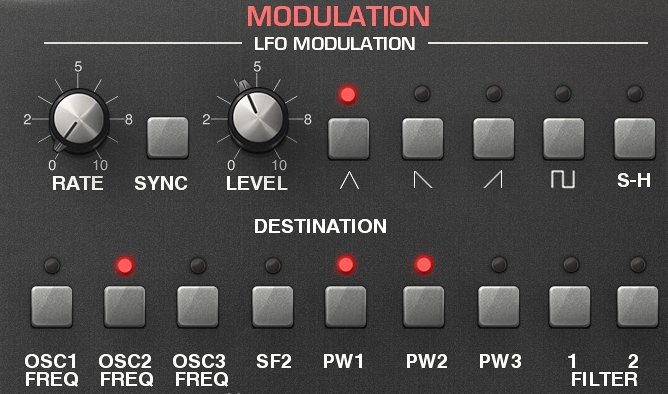
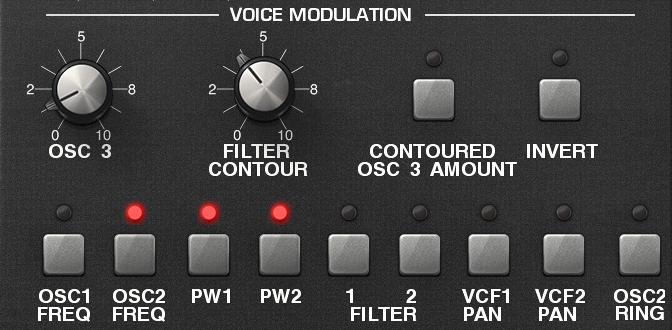








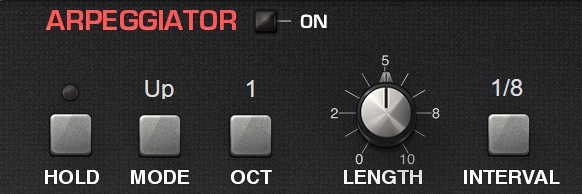


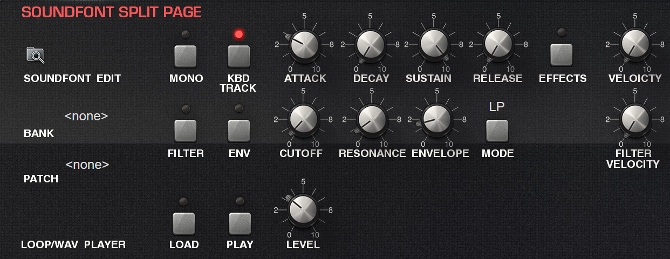

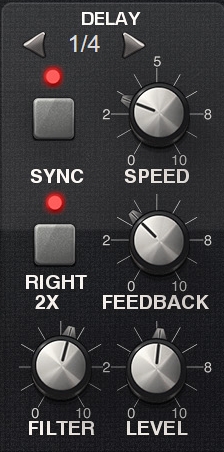







 العرض العادي
العرض العادي



